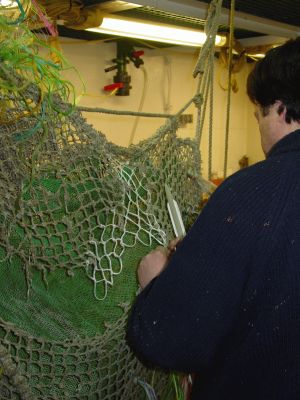Dispatch: June 3, 2006
|
|
Lat/Long: S67°
38.234' W68° 14.209'
Wind: N 23kn
Air Temp: 3.1°C Wind Chill: -11.2°C
Surface Water Temp: -1.582°C
Day's menu: Ribeye steak, salmon, asparagus, spinach, salad; Hot wings, chili, vegs, rice, salad, frosted brownies, cake, bread pudding and cookies.
» View additional images from today
Rothera and Ryder Bay
The first daylight operations are taking place in Ryder Bay. We are facing Anchorage Island, with Donnelly Island to the left of it. On our starboard is a view of Rothera Point on Adelaide Island, and the British Rothera Base is tucked in an inlet there. Guinness anyone? Rick L. suggests, "I’ll bet they’ll deliver!!". Ah, but the show must go on. Among other things, 2 fish traps are put out in the bay at noon. They will sit on the bottom for 12 hours, and we will return to retrieve them via their GPS location, plus the orange floats with flashing light system. The hope is to get intact, live benthic ‘volunteers’ for, among others the starfish collection.

MTs Rick Lichtenhan and Stian Alesandrini ready the fish
traps. (Photo by Pam Polloni)
|

MT Rick Lichtenhan javelin-throws the beacon into the bay to mark the trap. (Photo by Steve Alexander)
|
Friday night’s benthic trawl was another rock trawl. I mean really, a rock trawl. Several rocks were retrieved safely from the ocean floor. Fortunately, the benthic critters that accompanied them were identifiable for the specimen collection. They continue to see a great diversity in the types of critters they gather, both individually and by family. The students and the Chief Scientist are very happy with the results so far.

Chief Sci. Ken Halanych is a happy guy, going home with the coffers full. (Photo by Ellen Bailey)
|
In the course of hauling rocks along with the critters, the nets take a terrible beating, tumbling those rocks along the ocean floor. We are fortunate to have a wonderful Chilean seaman, Gustavo Canas Rodriguez, who before this gig was a fisherman for 22 years in many parts of the world. His skills at mending nets have been a godsend. He has also shown us new ways to attach lines that make them pass through rigging more efficiently. We are pleased to have Gustavo in our midst for his professional skills as well as his very pleasant manner.

Gustavo steps in to help out on deck.
|

Gustavo’s handiwork is clearly seen on this net repair.
|
| [Photos by Pam Polloni] |
Getting to Know You

(Photo by E. Bailey)
|
Dr. Jennifer Putland writes...
I recently completed a PhD in Biological Oceanography from Florida State University. The study site for my research was Apalachicola Bay, a highly productive estuary located in the northern Gulf of Mexico. The Bay serves as a habitat and nursery to a wide variety of commercial and sport fish species such as oyster, sheepshead, seatrout, herring, shrimp, and blue crab. The high productivity is the result of the Apalachicola River delivering freshwater and nutrients to the Bay. Freshwater moderates salinity in the Bay which creates a suitable habitat for estuarine flora and fauna. Nutrients delivered to the Bay support high levels of phytoplankton productivity which, in turn, supports secondary productivity. Diversion of water from the watershed that feeds the Apalachicola River has been proposed for the summer in order to satisfy domestic and agricultural needs. A detailed understanding of the ecology of key constituents of the estuarine food web, such as phytoplankton and zooplankton in the Bay would be valuable in predicting the impact of river water diversion on Apalachicola Bay. Based upon the results of my dissertation, reduced river discharge during summer can be expected to reduce phytoplankton and zooplankton productivity and as a result higher trophic level (e.g. fish, oysters, crab) productivity in Apalachicola Bay. The data acquired from this study can be used to help manage discharge from the Apalachicola River so as to maintain the productivity of Apalachicola Bay.
Within the next two years, I will be studying the ecology of krill in the Antarctic as well as the ecology of microzooplankton in Florida estuaries. Although these areas of research are distinct, they are similar in that both krill and microzooplankton are key components of the planktonic food web in the Antarctic and estuaries in Florida, respectively. Studies which improve our understanding of their ecology are needed, especially as they relate to climate change, pollution, and river water diversion.
back
|
|
